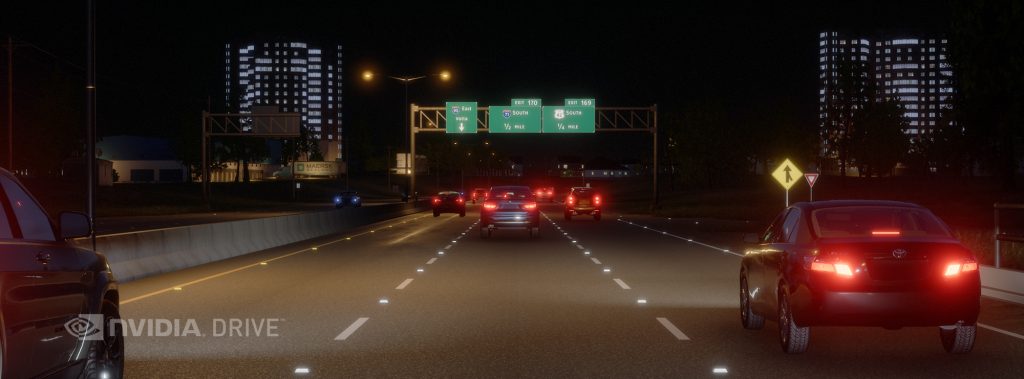New Datacenter Solution Integrates NVIDIA DRIVE Pegasus, Runs DRIVE Sim Software for Extensive Testing and Validation of Self-Driving Cars
Tuesday, March 27, 2018 — GPU Technology Conference — NVIDIA today introduced a cloud-based system for testing autonomous vehicles using photorealistic simulation – creating a safer, more scalable method for bringing self-driving cars to the roads.
Speaking at the opening keynote of GTC 2018, NVIDIA founder and CEO Jensen Huang announced NVIDIA DRIVE™ Constellation, a computing platform based on two different servers.
The first server runs NVIDIA DRIVE Sim software to simulate a self-driving vehicle’s sensors, such as cameras, lidar and radar. The second contains a powerful NVIDIA DRIVE Pegasus™ AI car computer that runs the complete autonomous vehicle software stack and processes the simulated data as if it were coming from the sensors of a car driving on the road.
“Deploying production self-driving cars requires a solution for testing and validating on billions of driving miles to achieve the safety and reliability needed for customers,” said Rob Csongor, vice president and general manager of Automotive at NVIDIA. “With DRIVE Constellation, we’ve accomplished that by combining our expertise in visual computing and datacenters. With virtual simulation, we can increase the robustness of our algorithms by testing on billions of miles of custom scenarios and rare corner cases, all in a fraction of the time and cost it would take to do so on physical roads.”
The simulation server is powered by NVIDIA GPUs, each generating a stream of simulated sensor data, which feed into the DRIVE Pegasus for processing.
Driving commands from DRIVE Pegasus are fed back to the simulator, completing the digital feedback loop. This “hardware-in-the-loop” cycle, which occurs 30 times a second, is used to validate that algorithms and software running on Pegasus are operating the simulated vehicle correctly.
DRIVE Sim software generates photoreal data streams to create a vast range of different testing environments. It can simulate different weather such as rainstorms and snowstorms; blinding glare at different times of the day, or limited vision at night; and all different types of road surfaces and terrain. Dangerous situations can be scripted in simulation to test the autonomous car’s ability to react, without ever putting anyone in harm’s way.
“Autonomous vehicles need to be developed with a system that covers training to testing to driving,” said Luca De Ambroggi, research and analyst director at IHS Markit. “NVIDIA’s end-to-end platform is the right approach. DRIVE Constellation for virtually testing and validating will bring us a step closer to the production of self-driving cars.”
DRIVE Constellation will be available to early access partners in the third quarter of 2018.
About NVIDIA
NVIDIA‘s (NASDAQ:NVDA) invention of the GPU in 1999 sparked the growth of the PC gaming market, redefined modern computer graphics and revolutionized parallel computing. More recently, GPU deep learning ignited modern AI — the next era of computing — with the GPU acting as the brain of computers, robots and self-driving cars that can perceive and understand the world. More information at http://nvidianews.nvidia.com/.


